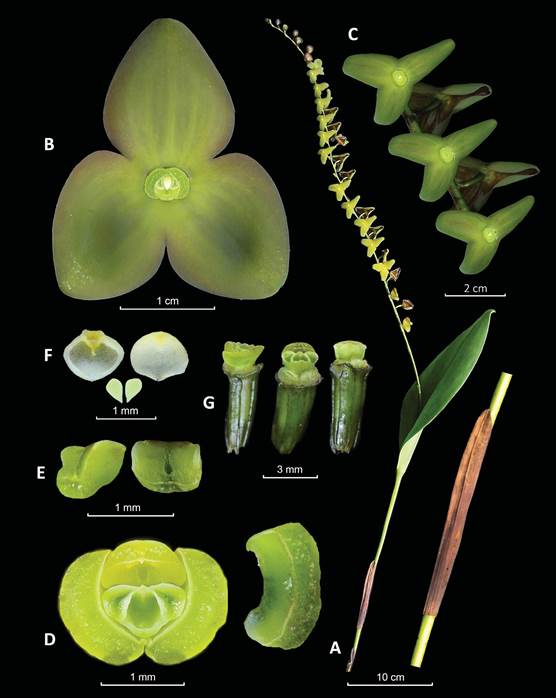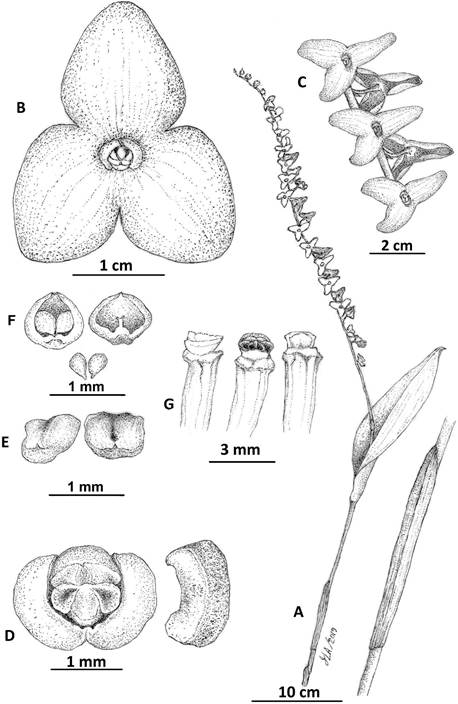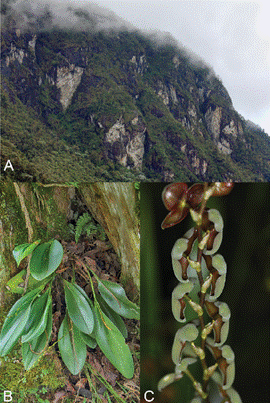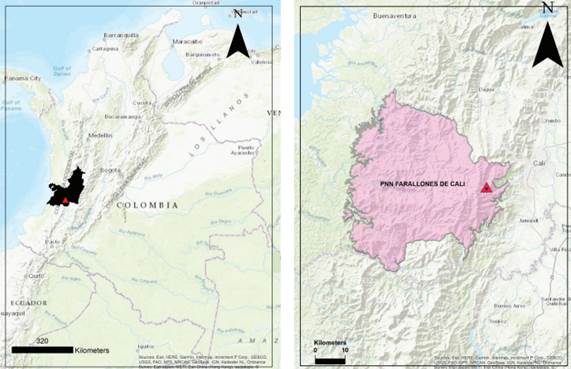Introduction
With +1240 species in its broadest cir- cumscription, the Neotropical genus Stelis Swartz (Orchidaceae) is the largest in subtribe Pleurothallidinae, and one of the largest genera of the Orchidaceae family (Karremans 2019). Many of the taxa occur in large sympatric populations restricted to the humid environ- ment from Florida (USA), through Central America and the Antilles, to Brazil and Paraguay (Karremans 2013, GBIF 2020). Stelis is one of the most important epiphytic components of the Andean forest, especially the members of Stelis subgen Stelis which include over 1030 species with the typical Stelis flower morphology (Karremans 2019).
For Colombia, Luer (2016) reported 240 species of Stelis subgen. Stelis, of which Betancur et al. (2015) regarded 114 as endemic. Additional revisions of the Colombian members of subgen. Stelis (Luer 2016a, 2016b, 2017a, 2017b, 2018a, 2018b) revealed 235 new species. An exhaustive species-by-species count showed the new number of 496 species for the country. In this way, Colombia accounts for about 48% of the global diversity of that subgenus and the 40% of the genus Stelis in its broadest circumscription. Because of the complexity and variety of ecosystems, high rainfall, microclimate diversity and orographic fac- tors, in Colombia, there are still gaps in our knowledge of orchid biodiversity, in particular, the forest canopy remains to be throughly explored (Reina-Rodríguez 2016, 2019).
Stelis is a taxonomically challenging genus. Many species are only known from historical illustrations and very brief descriptions, and herbaria are plagued with unidentified specimens and misidentifications. Moreover, currently there are few systematists special- izing on it (Solano-Gómez 2014). In general terms members of subgen. Stelis can be recognized by the terminal, racemose, fascicled, few or multi-flowered inflorescences, the triangular flowers with almost identical sepals, tending to radial symmetry, diversely connate sepals much larger than the petals and lip, the very reduced petals usually with a thick margin, the thickened lip that is similar to the petals, and a very short, unwinged column with an apical stigma and anther (Luer 2003).
Recent studies in “El Danubio”, in the north area of Farallones de Cali National Park, recorded 218 angiosperms species, 165 genera in 73 families. The most species-rich plant families in the areas are: Rubiaceae (16 species), Orchidaceae (15), Araceae (10) and Gesneriaceae (10). (Giraldo-Rodríguez et al. 2016). From the 2017, to the present, the number of orchids reported in “El Danubio” increased five times, reaching 88 species as a result of a joint effort between the DAGMA ranger from the Cali mayoralty, Calidris Association and our team. Some of them are the first report for the country, making this place attractive for orchid studies and ecotourism.
During an expedition in 2019 to El Danubio-Peñas Blancas, an undescribed species belonging to Stelis subgen. Stelis was discovered and it is described here- in.
Material and methods
The plant material was collected in “El Danubio” Farallones de Cali National Park, Western Andes of Colombia and preserved as spirits and dried specimens at the CUVC herbarium, Universidad del Valle in Cali. The spirit material was used to prepare the line drawing. The photographs were taken in situ, dissections of the plant and flower according to Lankester Composite Dissection Plate (LCDP) format using a Cannon EOS 60D®, with 60 mm, 65 mm 1-5X and 100 mm macro lenses. The pho- tographs were edited using Adobe Photoshop® CS4.
Location maps were prepared using ArcGIS 10, mod- ule ArcMap ESRI ®, the official shapefile of La Elvira was downloaded from (http://runap.parquesnaciona- les.gov.co). The conservation assessment complies with the criteria of the IUCN (2001). We used the web- site (http://es.climate-data.org) to determine the weather conditions in Colombia, and Ecuador. Authors and names of plants follow The International Plant Name Index, IPNI (2019) (http://www.ipni.org). The new species was also compared with all Stelis species described from Colombia (Duque 2010a, Duque 2010b, Luer 2016a, 2016b, 2017a, 2017b, 2018a, 2018b) to confirm uniqueness.
Taxonomic treatment
Stelis excentrica Reina-Rodr. & López-Mach., sp. nov. (Fig. 1-3).
TYPE: Colombia. Valle del Cauca: Municipio de Cali, Corregimiento Los Andes, sector Los Cárpatos. Microcuenca del río Pichindé, afluente del río Cali. Cabaña “El Danubio” Planta terrestre en epifitario, traída de los alrededores. Bosque subandino, 2252 m, 20 de marzo 2019, G. Reina-Rodríguez 2957, F. López-Machado, B. Bermúdez, J. Cruz. (holotype: CUVC-spirit; isotype COL) . Fig. 1-2.
Diagnosis: Stelis excentrica Reina-Rodr. & López- Mach. is distinguished from Stelis gigantissima Luer by its elliptic, subpeciolate, obtuse leaf (vs. orbicular- elliptic, sessile, rounded), inflorescence two times longer than the leaf blade (vs. three times longer), the ocher green flowers (vs. dark purple) with glossy re- flexed sepals (vs. flat sepals), a subquadrate, shortly apiculate lip, (vs. subcuneate not apiculate), glenion in T-shape and rounded apically (vs. subtrilobed). The new species is also similar to Stelis superbiens Lindl. but is distinguished by the significantly longer inflores- cence (60 cm vs. 15-30 cm long), the ocher green color flowers (vs. pale yellow suffused with purple), the much larger flowers, e.g. dorsal sepal 13-15 × 7.0-9.0 mm (vs. 5-10 × 6-10).
Plant terrestrial, 70-90 cm tall excluding the in- florescence, erect to sub-erect, monophyllus. Roots velamentous, flexuous, cylindrical. Ramicauls up to 60 cm long, erect to sub-erect, terete, enclosed by 1-2 appressed, sheaths around the middle and base of the ramicaul. Sheaths 6-7-veined, tubular, oblique, papyraceous, broad and flattened towards the apex, 8.7-10.1 cm long. Leaf blade 26.8-28.2 × 10.3-10.5 cm, coriaceous, lustrous, elliptical, apex acuminate, emarginate. Inflorescence 60 cm long, single, racemose, erect, decumbent in natural posi- tion, arising from apex of the stem, peduncle 15- 17 cm long, with two tubulars, acuminate sheaths, the longest 8.7 cm long. Floral bracts 0.8-1.0 cm long, light green, obliquely funnel-shape. Pedicels green, arching, 0.9-1.0 cm. Flowers 2.6-3.1 cm in diameter, ochraceum green color, 25-34, simul- taneously opening 3/4 parts from the base and the last 1/3 in flower buds. Ovary straight, glossy with ribs, 6.0-7.0 × 1.0-2.0 mm. Dorsal sepal, 13-15 × 7.0-9.0 mm, connate with lateral sepals in 0.2 cm, ovate, rounded, markedly reflexed along the margins, green-ochraceum with soft texture adaxially and shiny brown abaxially, subapically papillose, 5-veined. Lateral sepals 12-14 × 7.0-11 mm, con- nate basally with dorsal sepal in 3 mm, oblique- ly ovate, apex rounded, subapically papillose, 5-veined. Petals 1.7-2.3 × 0.8-1.0 mm, concave, embracing totally the column and partially the label- lum, kidney shaped, apex broadly rounded, slightly overlapped each to other in the columnar side, thick margin with microscopic crystals dots (calcium oxa- late). Lip 1.0-1.2 × 0.7-0.9 × 0.8-0.9 mm, subquad- rate, slightly concave, rounded, shortly apiculate, base truncate, hinged to the base of the column; Cal- lus triangular with glenion in T-shape, raised, ex- tended from the base to the middle of the lip, hirsute in its middle part and rounded apically. Column 1.0 mm long × 0.8 mm wide, erect, triangular in cross- section, widely bilobed stigmatic lobes with sharp margins and microscopic crystals dots. Anther 0.6 mm long x 0.4 wide, apical, orbicular-ovoid, cucul- lated. Pollinarium formed by two yellow pollinia, obovate, attenuated toward the base, 0.5 mm long × 0.3 mm wide, attached to elastic caudicles and dropof hyaline, disc-shaped, orange viscidium. Column not seen.

A. Habit and sheaths
B. Frontal view of the flower
C. Flowers in the inflorescence
D. Dissected perianth.
E. Lip in lateral and frontal view
F. Pollinia and anther cap dissected
G. Column and ovary, dorsal, frontal and overhead view.
Photographs by Francisco López-Machado and Guillermo Reina-Rodríguez of the plant that served as type No. 2957 G. Reina- Rodríguez et al. (CUVC-Spirit).
Figure 1. Lankester Composite Dissection Plate (LCDP) of Stelis excentrica Reina-Rodr. & López-Mach.

A. Habit and Sheaths
B. Frontal view of the flower
C. Segment of the inflorescence
D. Petals, lip, and column in frontal view.
E. Lip in lateral and frontal view
F. Pollinia and anther cap dissected
Drawing by Jairo Larrahondo Aguilar from the type.
Figure 2 Ink illustration of Stelis excentrica Reina-Rodr. & López-Mach.

Photographs by F. López-Machado (A-B) and G. Reina-Rodríguez (C).
Figure 3 A. Peñas Blancas, cliff of Cretaceous period with vegetation where the type specimen of S. excentrica was found. B. Plant habit in situ. C. Floral bracts top view.
Etymology
The name derived from the Latin excentricus, eccentric, referring to the unusual size of the flower and inflorescence.
Phenology
In their habitat the plant was in blooming in March, April, November and December; coinciding with the two rainy peaks that dominate the bimodal rainfall regime in the area
Conservation status
We assume that it is endemic to the Farallones de Cali since no records are known from the north or south of the western Andes. Its presence extension area is confined to less than 483 km2. It complies with Criterion B1a for the EN (Endangered) category according to IUCN (2012).
Ecology and distribution
Stelis excentrica is known only from the type specimen found in the middle and upper part of the Cali river basin, in the Valle del Cauca department of Colombia, at 2200- 2800 m of elevation. The average annual tempera- ture is 17°C. Precipitation is reported as between 1900 to 2100 mm. This area has slopes of 20-50%, on deep and well-drained soils from volcanic of Cretaceous (CVC 2010) (Fig. 3A). The area was classified as Montane rain forest (Holdridge 1987); the humid winds coming from the Pacific Ocean, which, when hitting the mountain top, is condensed, producing haze and strong precipitations known as orographic rains. (DAGMA 2014).

Figure 4. Map of location where the type specimen of S. excentrica Reina-Rodr. & López-Mach. was collected.
The main plant elements associated with the new species are: canopy above 10 m: Quercus humbold- tii Bonpl. (Fagaceae), Spirotheca rosea (Seem.) P.E. Gibbs & W.S.Alverson (Malvaceae), Otoba lehman- nii (A.C.Sm.) A.H. Gentry., (Myristicaceae). Subdo- sel species <6 m: Brunellia comocladifolia Bonpl. (Brunelliaceae), Alchornea latifolia Sw. (Euphorbia- ceae), Hedyosmum bonplandianum Kunth. (Chloran- thaceae) and Miconia caudata DC. (Melastomataceae) (CVC 2015). In addition, there is a community of epi- phytes dominated by the genus: Cyrtochilum Kunth., Epidendrum L., Lepanthes Sw., Masdevallia Ruiz & Pav., Maxillaria Ruiz & Pav., Oncidium Sw, and Pleu- rothallis R.Br.
At the present, this species is probably the largest flower of the subgenus Stelis registered. It differs from its rival Stelis gigantissima in the flower color (ocher green flowers (vs. dark purple); sepals with folded margins (vs. unfolded), sepals abaxially bright (vs. dull) and the triangular “T” shaped glenion of the lip (vs. subtrilobed). See (Table 1)
Table 1. Differences between Stelis excentrica vs. Stelis gigantissima, in terms of abiotic conditions and morphology.
| Traits | Stelis excentrica | Stelis gigantissima |
|---|---|---|
| Abiotic conditions | ||
| Countries | Colombia Southwest | Ecuador East |
| Biogeographic range | Western Andes middle lands | Amazon basin middle lands |
| Life zone | Montane rain forest (Holdridge 1987) | Tropical moist forest (Holdridge 1987) |
| Elevation | 2200-2800 | 1000-1900 |
| Mean annual rainfall (mm) | 2000-2500 | 2200-4000 |
| Mean temperture (°C) | 17°C | 22.3°C |
| Morphology/Phenology | ||
| Biotype | Terrestrial | Epiphyte to terrestrial |
| Flowering | March, April, November, December | November |
| Ramicauls (cm) | 59 | 35 |
| Leaf blade size (cm) | 28.2 × 10.5 | 25 × 20 |
| Floral bracts | Oblique, acuminate, acute. | Oblique-Obtuse. |
| Floral bracts (mm) | 8.0-10.0 | 3.0 |
| Inflorescence long (cm) | 60 | 75 |
| Ovary (mm) | 6.0-7.0 | 3.0 |
| Sepals (mm) | 15.0 × 11.0 | 14 × 7.5 |
| Flower length (from apex of dorsal sepal to apex of lateral sepal) (mm) | 30.6 | 27 |
| Flowers color | Ocher green | Dark Purple |












 uBio
uBio 

